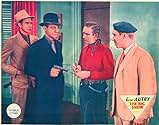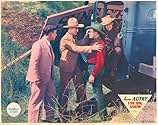Añade un argumento en tu idiomaAt the Texas Centennial in Dallas Autry confuses two girls by being himself and his own stunt double.At the Texas Centennial in Dallas Autry confuses two girls by being himself and his own stunt double.At the Texas Centennial in Dallas Autry confuses two girls by being himself and his own stunt double.
- Dirección
- Guión
- Reparto principal
The Jones Boys
- Singers
- (as Jones Boys)
The Beverly Hillbillies
- Musicians
- (as Beverly Hill Billies)
The Light Crust Doughboys
- Musicians
- (as Light Crust Dough Boys)
Jack O'Shea
- Henchman Joe
- (as Jack O'Shay)
Reseñas destacadas
Mammoth Pictures star Tom Ford decides to go on vacation, but the studio's press agent Wilson needs to get ahold of him so he can make a scheduled appearance at the Texas Centennial in Dallas. The problem is solved when Wilson convinces Ford's stuntman, Gene Autry (Autry also doubles as Ford here), to go to the event impersonating Ford. The ruse works, but things go wrong when Autry decides to go on the radio singing, which Ford can not do. This ticks off Ford, who comes back to the studio to get Autry fired, but some gangsters are at the Centennial hoping to collect some of Ford's gambling debts from Autry. This film is good, but nothing more than a promo film for both the Centennial and Autry & the singing groups at Republic, as well as the studio itself. There are some pretty good action scenes at the beginning with Autry as the stuntman. Autry as Ford, however, doesn't convince anyone since his thespian abilities were never great (especially this early in his career). Fun to watch. Rating, based on B westerns, 7.
The likable Gene Autry plays a dual role and has some good opportunities to use his variety of talents in this enjoyable B-Western. The story is light but entertaining, and it has some good musical numbers plus some comic relief from Smiley Burnette. The Texas Centennial setting also gives it some additional historical interest.
Autry plays both a bad-tempered movie star cowboy and his talented, good-natured stunt double, so the setup offers some good lighter moments in its look at the movie industry. The story starts with the stunt double filling in for the star at a public appearance, with numerous complications arising from there. Autry gets many opportunities to sing, and there are also some good action sequences.
Most of it works pretty well, because it generally allows Autry to use his strengths. Burnette also gets some good moments, and while the story is mostly used to showcase Autry and the other musical entertainment, it works too as a way of pulling things together.
Autry plays both a bad-tempered movie star cowboy and his talented, good-natured stunt double, so the setup offers some good lighter moments in its look at the movie industry. The story starts with the stunt double filling in for the star at a public appearance, with numerous complications arising from there. Autry gets many opportunities to sing, and there are also some good action sequences.
Most of it works pretty well, because it generally allows Autry to use his strengths. Burnette also gets some good moments, and while the story is mostly used to showcase Autry and the other musical entertainment, it works too as a way of pulling things together.
For one of eight films that Republic Pictures new singing cowboy star Gene Autry appeared in 1936, the studio did the unheard of thing and filmed part of the story at the Texas State Centennial at their state fairgrounds in Dallas. In fact the centennial was an integral part of the story.
In a film with plot elements similar to MGM's Callaway Went Thataway, Gene Autry plays two roles that of himself who is fearless stunt double who happens to sing to Tom Ford, arrogant movie cowboy who doesn't and also played by Autry.
In fact Ford has himself in some trouble with gamblers and has to lam out to parts unknown after his last pictures wraps. Which leaves the studio holding the bag because they promised an appearance by their star at the Texas Centennial. Studio head Charles Judel is nursing his growing ulcer as a result.
Then studio yes man William Newell gets the idea to get Autry to impersonate Ford and when he sings on the radio and in personal appearances, Mammoth Pictures figures it has a star with greater venues.
If you've seen Callaway Went Thataway you know what happens. The Big Show turned out to be one of Gene's better early westerns.
A lot of acts get in the act in this film and Gene has two special numbers, Nobody's Darlin' But Mine and Ole Faithful. The latter was a cowboyballad written in England and introduced in America by Bing Crosby on his radio show.
Gene gets to romance Kay Hughes and Smiley Burnette and Sally Payne are around for comic relief. One of Gene's better early Republic westerns.
In a film with plot elements similar to MGM's Callaway Went Thataway, Gene Autry plays two roles that of himself who is fearless stunt double who happens to sing to Tom Ford, arrogant movie cowboy who doesn't and also played by Autry.
In fact Ford has himself in some trouble with gamblers and has to lam out to parts unknown after his last pictures wraps. Which leaves the studio holding the bag because they promised an appearance by their star at the Texas Centennial. Studio head Charles Judel is nursing his growing ulcer as a result.
Then studio yes man William Newell gets the idea to get Autry to impersonate Ford and when he sings on the radio and in personal appearances, Mammoth Pictures figures it has a star with greater venues.
If you've seen Callaway Went Thataway you know what happens. The Big Show turned out to be one of Gene's better early westerns.
A lot of acts get in the act in this film and Gene has two special numbers, Nobody's Darlin' But Mine and Ole Faithful. The latter was a cowboyballad written in England and introduced in America by Bing Crosby on his radio show.
Gene gets to romance Kay Hughes and Smiley Burnette and Sally Payne are around for comic relief. One of Gene's better early Republic westerns.
The Big Show is about the most enjoyable to watch of all his movies for several reasons: One, Mr. Autry plays a double role. Two, there is a lot of clever stunt work, including the famous under the coach and handover hand to the horses stunt. Three, The Big Show has a very different plot from the usual Autry Western. Four, The Big Show contains some very listen-able songs. Five, it is really fun to see Roy Rogers when he was still with the Sons of the Pioneers as Leanard Slye. Six, it is also fun to see behind the scenes of movie making, with some back views of the Republic lot. Seven, since this is an earlier Autry entry, Smiley Burnett is Mr. Autry's side kick rather than Pat Butram. Eight, it is exciting to see the Texas Centennial Celebration as a background. All in all, this is one is really fun.
Gene Autry is the stunt double for a conceited western star and has to impersonate him after the actor bails out of a big personal appearance at the Texas Centennial, not knowing that the reason star went on vacation was to avoid paying his gambling debts. Gene gets in way over his head when he turns out to be a bigger hit than expected and gangsters show up to collect their money.
A pleasant, fictionalized account of how Gene Autry became a star, The Big Show offers an irresistible glimpse at the duties that befall a Saturday matinée western star. Despite a loose plot, it's really a lot of fast-paced, tongue-in-cheek fun.
Autry sings some great songs and along with sidekick Smiley Burnette, joins three legendary western groups, The Sons Of The Pioneers (with Roy Rodgers), The Light Crust Doughboys (a personal favorite), and The Beverly Hill Billies. Max Terhune and his dummy even show up for a quickie appearance. Sadly, The Doughboys and the singing group The Jones Boys are deleted from most, if not all video prints.
Although not really much of a western, Autry fans should be satisfied.
A pleasant, fictionalized account of how Gene Autry became a star, The Big Show offers an irresistible glimpse at the duties that befall a Saturday matinée western star. Despite a loose plot, it's really a lot of fast-paced, tongue-in-cheek fun.
Autry sings some great songs and along with sidekick Smiley Burnette, joins three legendary western groups, The Sons Of The Pioneers (with Roy Rodgers), The Light Crust Doughboys (a personal favorite), and The Beverly Hill Billies. Max Terhune and his dummy even show up for a quickie appearance. Sadly, The Doughboys and the singing group The Jones Boys are deleted from most, if not all video prints.
Although not really much of a western, Autry fans should be satisfied.
¿Sabías que...?
- CuriosidadesAlmost all the scenes were filmed on location at the (then) brand-new Fair Park in Dallas, TX, which served as the location of the 1936 Texas Centennial and has served as the location of the Texas State Fair since. Many of the buildings in the film still exist in what has been called the largest collection of art deco buildings in the world. Also seen is the Gulf Radio Studios building (this is not the WRR Studios; WRR is the only city-owned radio station in the country and still broadcasts from new studios adjacent to Science Place II). The lagoon was pretty barren back then, and Dallas trolley cars which served downtown at the time had just been expanded to Fair Park to service the Centennial. The Cotton Bowl, which was constructed in 1930 and renamed The Cotton Bowl for the Centennial, is seen briefly in the background as Gene Autry rides out of the Cavalcade set in the chase scene.
- PifiasThe Light Crust Doughboys and The Jones Boys appear in the credits, but do not appear in the shortened (54 minutes) version, but along with some additional action they appear in the original (71 minutes) movie.
- Citas
Lee Wilson: Oh why was I ever born?
Gene Autry: Now this is no time for riddles.
- ConexionesFeatured in Gene Autry: White Hat, Silver Screen (2007)
- Banda sonoraThe Martins and the Coys
(1936) (uncredited)
Music and Lyrics by Ted Weems and Al Cameron
Performed by Gene Autry, Smiley Burnette and The Beverly Hillbillies
Selecciones populares
Inicia sesión para calificar y añadir a tu lista para recibir recomendaciones personalizadas
Detalles
- Fecha de lanzamiento
- País de origen
- Idioma
- Títulos en diferentes países
- Astro por Aclamação
- Localizaciones del rodaje
- Fair Park, Dallas, Texas, Estados Unidos(1936 Texas Centennial Exposition)
- Empresa productora
- Ver más compañías en los créditos en IMDbPro
- Duración
- 1h 11min(71 min)
- Color
- Relación de aspecto
- 1.37 : 1
Contribuir a esta página
Sugerir un cambio o añadir el contenido que falta


















